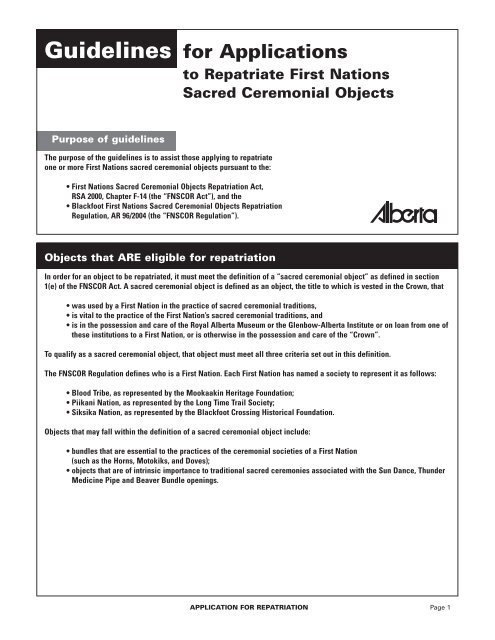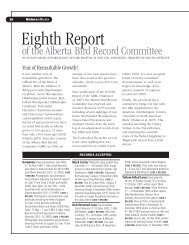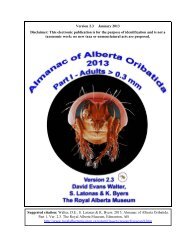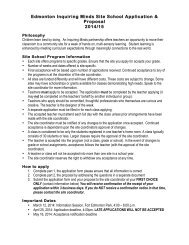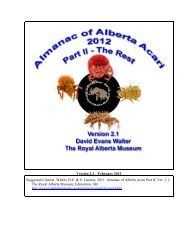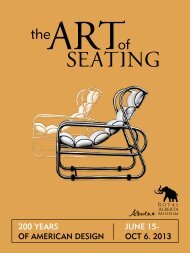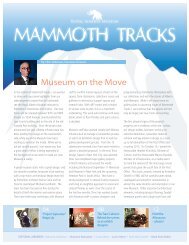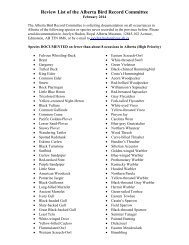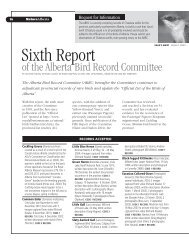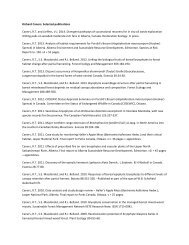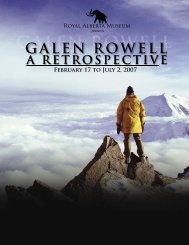application form - Royal Alberta Museum
application form - Royal Alberta Museum
application form - Royal Alberta Museum
Create successful ePaper yourself
Turn your PDF publications into a flip-book with our unique Google optimized e-Paper software.
Guidelines for Applicationsto Repatriate First NationsSacred Ceremonial ObjectsPurpose of guidelinesThe purpose of the guidelines is to assist those applying to repatriateone or more First Nations sacred ceremonial objects pursuant to the:• First Nations Sacred Ceremonial Objects Repatriation Act,RSA 2000, Chapter F-14 (the “FNSCOR Act”), and the• Blackfoot First Nations Sacred Ceremonial Objects RepatriationRegulation, AR 96/2004 (the “FNSCOR Regulation”).Objects that ARE eligible for repatriationIn order for an object to be repatriated, it must meet the definition of a “sacred ceremonial object” as defined in section1(e) of the FNSCOR Act. A sacred ceremonial object is defined as an object, the title to which is vested in the Crown, that• was used by a First Nation in the practice of sacred ceremonial traditions,• is vital to the practice of the First Nation’s sacred ceremonial traditions, and• is in the possession and care of the <strong>Royal</strong> <strong>Alberta</strong> <strong>Museum</strong> or the Glenbow-<strong>Alberta</strong> Institute or on loan from one ofthese institutions to a First Nation, or is otherwise in the possession and care of the “Crown”.To qualify as a sacred ceremonial object, that object must meet all three criteria set out in this definition.The FNSCOR Regulation defines who is a First Nation. Each First Nation has named a society to represent it as follows:• Blood Tribe, as represented by the Mookaakin Heritage Foundation;• Piikani Nation, as represented by the Long Time Trail Society;• Siksika Nation, as represented by the Blackfoot Crossing Historical Foundation.Objects that may fall within the definition of a sacred ceremonial object include:• bundles that are essential to the practices of the ceremonial societies of a First Nation(such as the Horns, Motokiks, and Doves);• objects that are of intrinsic importance to traditional sacred ceremonies associated with the Sun Dance, ThunderMedicine Pipe and Beaver Bundle openings.APPLICATION FOR REPATRIATION Page 1
Objects that ARE NOT eligible for repatriationAn object that does not meet the definition of a sacred ceremonial object cannot be repatriated. Such objects would include:• replicas of a true sacred ceremonial object;• objects of purely personal or familial significance; and• objects that were used at but were not vital to a traditional sacred ceremony, such as garments and tipi furnishings.To avoid unnecessary time and expense, before submitting any <strong>application</strong>, an applicant is encouraged to contact theAboriginal Liaison Officer for assistance to determine:• what objects could be subject to repatriation;• whether any objects are in the possession of the <strong>Royal</strong> <strong>Alberta</strong> <strong>Museum</strong>, the Glenbow-<strong>Alberta</strong> Institute,or elsewhere;• how to properly identify any objects; and• how to properly complete an <strong>application</strong>.Completing the <strong>application</strong> for repatriationAn <strong>application</strong> to repatriate an object as a sacred ceremonial object begins with completing an official Application ForRepatriation (the “AFR”) and submitting it to the Aboriginal Liaison Officer at the <strong>Royal</strong> <strong>Alberta</strong> <strong>Museum</strong>, at the address andwithin the deadlines appearing on the AFR.The completed AFR as well as any supporting documentation or other evidence, and any input submitted by other persons,will be evaluated by the Minister of Tourism, Parks, Recreation & Culture to determine whether the object meets thecriteria of a sacred ceremonial object, and if so, whether it is appropriate to repatriate it.Therefore, it is very important that the AFR be as complete as possible. The AFR has several sections to be completed. These include;Part AName and statement by an individual agreeing to put the objectback into use as a sacred ceremonial objectPart A of the AFR identifies the individual who has made a request to the society for an object, and includes an agreementby that individual to put that object back into use as a sacred ceremonial object. This is required by section 4(2) of theFNSCOR Regulation.Part BSociety representing a First NationPart B of the AFR indicates that the society representing the First Nation is aware that there is a request for an object fromthe person named in Part A, and that the society is authorized by Band Council Resolution to represent the First Nation. Thissection must be signed by a society’s authorized representative. This is required by section 2(1) of the FNSCOR Act, andsections 3 and 4 of the FNSCOR Regulation. In signing the <strong>application</strong> the society does not assume responsibility for theoutcome of the repatriation request.The named society acts solely as an intermediary between the museum and the individual. In signing the <strong>application</strong>, thesociety accepts the responsibility to convey custody of the object to the individual only after approval of the Minister. Thesociety does not have the power to decide the outcome of a repatriation request; that authority rests with the Minister.GUIDELINES FOR APPLICATION FOR REPATRIATION Page 2
Part CName, catalogue number and location of each objectPart C of the AFR identifies the object being requested for repatriation. The object must be named or described; includethe <strong>Royal</strong> <strong>Alberta</strong> <strong>Museum</strong> or the Glenbow-<strong>Alberta</strong> Institute catalogue number for that object; and indicate where thatobject is presently located. The catalogue number is similar to a serial number and distinguishes that object from anyother object in a museum’s collections. The Aboriginal Liaison Officer can assist an applicant with properly identifying theobject listed in Part C of the AFR.If more than one object is being requested, use a separate Schedule “A” for each object.Part DEstablishing that the object was used by a First Nationas a sacred ceremonial object in the pastFor the object listed in Part C of the AFR, Part D is used to:• identify the sacred ceremonial tradition(s) in which the object was used, and• describe how the object was vital to that sacred ceremonial tradition(s).The AFR may include evidence supporting how the object was used by the First Nation as a sacred ceremonial object.If the object is not directly associated with your Blackfoot First Nation, please attach three letters of support fromceremonialists of the originating First Nation. At least one of the ceremonialists, must, if possible, have the transferredrights to a similar type of object.If more than one object is being requested, use a separate Schedule “A” for each object.Part EEstablishing that the object is vital to the First Nation’s practiceof sacred ceremonial traditions in the present and futureFor the object listed in Part C of the AFR, Part E is used to:• identify the sacred ceremonial tradition(s) in which the object, if repatriated, will be used as a sacred ceremonial object, and• explain how the object is vital to that sacred ceremonial tradition(s).The AFR may include evidence supporting how the object will be used in sacred ceremonial traditions, and how such useis vital to them.If more than one object is being requested, use a separate Schedule “A” for each object.PLEASE NOTE: The supporting evidence included for Parts D and E may:• include oral traditions, histories, or interviews with elders and ceremonialists, and• be submitted in written, video, or audio <strong>form</strong>, in the English language; or if in another language, it mustbe accompanied with an English language translation.GUIDELINES FOR APPLICATION FOR REPATRIATION Page 3
The process after an AFR is completedDeadlines to submit an AFRThere are two AFR submission deadlines. These are February 15th and September 1st of each year. When an AFR issubmitted after one deadline, it will be processed after the next deadline.Public notice of each AFRAfter each submission deadline, a notice of each AFR received by the Aboriginal Liaison Officer will be:• published in the <strong>Alberta</strong> Gazette*,• sent to each First Nation, and• published in other appropriate publications as determined by the Minister of Tourism, Parks, Recreation & Culture.• posted on the <strong>Royal</strong> <strong>Alberta</strong> <strong>Museum</strong>'s website www.royalalbertamuseum.caThis notification process is intended to in<strong>form</strong> others with a potential interest in the AFR, and to give them an opportunityto obtain further in<strong>form</strong>ation or to make representations to the Minister.Second or subsequent AFR for the same objectAny second or subsequent AFR for an object that is already the subject of a pending repatriation <strong>application</strong>, must besubmitted to the Aboriginal Liaison Officer within 30 days after the first notice for that object is published in the <strong>Alberta</strong>Gazette. Public notice of any second or subsequent AFR will be given, similar to the notice given for the first AFR.Right to provide inputAny person who wants to make representations about an AFR, including any second or subsequent AFR for the sameobject, must do so in writing to the Aboriginal Liaison Officer within 30 days after the notice about that AFR is published inthe <strong>Alberta</strong> Gazette.These representations may be delivered, mailed, or faxed to the Aboriginal Liaison Officer at the address appearing onthe AFR.* The <strong>Alberta</strong> Gazette can be viewed online at http://www.qp.gov.ab.ca/display_gazette.cfmGUIDELINES FOR APPLICATION FOR REPATRIATION Page 4
Decision by the MinisterThe Minister of Tourism, Parks, Recreation & Culture will review each AFR including any representations any person makesabout it. The Minister may also obtain advice about any AFR from the Blackfoot Advisory Committee on <strong>Museum</strong> Relations.Where only one AFR is received for an objectIf the AFR:• meets the requirements of the FNSCOR Regulation, and• in the Minister’s opinion, repatriation of the object is appropriate, the Minister will agree to repatriate the objectas a sacred ceremonial object.Where two or more AFRs are received for the same objectThe Minister may decide:• which applicant to repatriate the object to, or• not to agree to repatriate the object if, in the Minister’s opinion, repatriation is not appropriate.Part F or Part G will be completed only after the <strong>application</strong>review process, and where the <strong>application</strong> is successful.Parts F and GCompleting a repatriationWhere the Minister agrees to repatriate an object as a sacred ceremonial object:• the Minister must complete and sign the transfer <strong>form</strong> set out in the Schedule to the FNSCOR Regulation, and• the society representing the First Nation must complete and sign the acceptance and agreement <strong>form</strong> set out inthe Schedule to the FNSCOR Regulation.Once these <strong>form</strong>s are completed and signed, the Minister through the Aboriginal Liaison Officer and the societyrepresenting the First Nation will make all necessary arrangements for the physical transfer of the sacred ceremonialobject to the society representing the First Nation. The society will ensure that the sacred ceremonial object is placed intothe custody of the individual named in Part A of the AFR.Responsibility for costsA First Nation, a society representing a First Nation, and any other person having an interest in a sacred ceremonial object,are each responsible for all their own costs relating to the repatriation of a sacred ceremonial object.GUIDELINES FOR APPLICATION FOR REPATRIATION Page 5
Application for RepatriationPlease refer to the accompanying guidelines for <strong>application</strong> requirements.If help is required with your <strong>application</strong>, please telephone (780) 453-9155 well before thedeadline. Toll free connection is available by first dialing 310-0000.Submit this <strong>application</strong> to:Aboriginal Liaison Officerc/o <strong>Royal</strong> <strong>Alberta</strong> <strong>Museum</strong>12845-102 AvenueEdmonton, <strong>Alberta</strong> T5N 0M6Fax: (780) 454-6629Application submission deadlines:February 15thSeptember 1stPart AName and statement by an individual agreeing to put the objectback into use as a sacred ceremonial objectI, ________________________________, being a member of the __________________________First Nation, request therepatriation of each object listed in Part C of this <strong>application</strong> as a sacred ceremonial object.If this <strong>application</strong> is successful, I agree to put each object back into use as a sacred ceremonial object.____________________________________________Signature____________________________________________Address____________________________________________NamePart BSociety representing a First NationThe __________________________________________ (the “society”) acknowledges that:(a) it is the authorized representative for the _________________________First Nation pursuant to Band Council Resolution# ____________________ for the purposes of section 2 of the FNSCOR Act and section 3 of the FNSCOR Regulation.(b) ___________________________________________ (individual named in Part A) is requesting the repatriation of eachobject listed in Part C of this <strong>application</strong>.(c) If this <strong>application</strong> is approved by the Minister, the society will convey custody of each object listed in Part C to the individualnamed in Part A of this <strong>application</strong>.____________________________________________Signature of authorized representative of the society____________________________________________Signature of authorized representative of the society________________________________________Date________________________________________DateDISCLAIMER: By signing this <strong>form</strong> the society representing a First Nation does not accept any responsibility for the outcome of the repatriation <strong>application</strong>.The named society acts solely as an intermediary between the museum and the individual. The society does not have the power to decide the outcome of arepatriation request; that authority rests with the Minister.APPLICATION FOR REPATRIATION Page 6
Part CName, catalogue number and location of each objectPlease provide a name, catalogue number and location for the object being requested for repatriation.If this <strong>application</strong> is for more than one object, please use a separate Schedule “A” for each object.Name of object_________________________________________Catalogue #________________________________Location: ❏ <strong>Royal</strong> <strong>Alberta</strong> <strong>Museum</strong> ❏ Glenbow-<strong>Alberta</strong> Institute❏ Other (please specify)_____________________________________________________________________Part DEstablishing that the object was used by a First Nationas a sacred ceremonial object in the pastPlease identify the sacred ceremonial tradition(s) in which the object was used in the past and explain how the object wasa part of that sacred ceremonial tradition(s). If the object is not directly associated with your Blackfoot First Nation, pleaseattach three letters of support from ceremonialists of the originating First Nation (at least one of the ceremonialistsmust, if possible, have the transferred rights to a similar object).If this <strong>application</strong> is for more than one object, please use a separate Schedule “A” for each object.________________________________________________________________________________________________________________________________________________________________________________________________________________________________________________________________________________________________________________________________________________________________________________________________________________________________________________________________________________________________________________________________________________________________________________________________________________________________________________________________________________________________________________________________________________________________________________________________________________________________Part EEstablishing that the object is vital to the First Nation’s practiceof sacred ceremonial traditions in the present and futurePlease identify the sacred ceremonial tradition(s) in which the object will be used in contemporary practice as a sacredceremonial object. Please explain how that object is vital to that sacred tradition. If this <strong>application</strong> is for more than oneobject, please use a separate Schedule “A” for each object.________________________________________________________________________________________________________________________________________________________________________________________________________________________________________________________________________________________________________________________________________________________________________________________________________________________________________________________________________________________________________________________________________________________________________________________________________________________________________________________________________________________________________________________________________________________________________________________________________________________________APPLICATION FOR REPATRIATION Page 7
Freedom of In<strong>form</strong>ation and Protection of Privacy ActCollection of the personal in<strong>form</strong>ation on this <strong>form</strong>, including any schedules, is authorized under the First Nations Sacred Ceremonial Objects Repatriation Act(FNSCORA) and is required for the purpose of repatriating any sacred ceremonial object pursuant to the Act. The in<strong>form</strong>ation will be used for assessing theeligibility of the <strong>application</strong> and is subject to disclosure rules set forth in the Freedom of In<strong>form</strong>ation and Privacy Act. This in<strong>form</strong>ation may be shared withFirst Nations representatives in the course of making a decision. For further in<strong>form</strong>ation about the collection and use of this personal in<strong>form</strong>ation, pleasecontact the Aboriginal Liaison Officer at the <strong>Royal</strong> <strong>Alberta</strong> <strong>Museum</strong>, (780) 453-9155. Outside Edmonton, call toll free first dialing 310-0000.For Administration Use Only____________________________________________ ______________________ ______________________Application received by (please print) Date Time____________________________________________Application reference numberAPPLICATION FOR REPATRIATION Page 8
SCHEDULE “A”For use when <strong>application</strong> is for more than one object.Use a separate schedule for each object.Part CName, catalogue number and location of the objectPlease provide a name, catalogue number and location for the object being requested for repatriation.Name of object_________________________________________Catalogue #_________________________________Location: ❏ <strong>Royal</strong> <strong>Alberta</strong> <strong>Museum</strong> ❏ Glenbow-<strong>Alberta</strong> Institute❏ Other (please specify)_____________________________________________________________________Part DEstablishing that the object was used by a First Nationas a sacred ceremonial object in the pastPlease identify the sacred ceremonial tradition(s) in which the object was used in the past and explain how theobject was a part of that sacred ceremonial tradition(s). If the object is not directly associated with your Blackfoot FirstNation, please attach three letters of support from ceremonialists of the originating First Nation (at least one of theceremonialists, must, if possible have the transferred rights to a similar object).________________________________________________________________________________________________________________________________________________________________________________________________________________________________________________________________________________________________________________________________________________________________________________________________________________________________________________________________________________________________________________________________________________________________________________________________________________________Part EEstablishing that the object is vital to the First Nation’s practiceof sacred ceremonial traditions in the present and futurePlease identify the sacred ceremonial tradition(s) in which the object will be used in contemporary practice as a sacredceremonial object. Please explain how the object is vital to the sacred ceremonial tradition(s).________________________________________________________________________________________________________________________________________________________________________________________________________________________________________________________________________________________________________________________________________________________________________________________________________________________________________________________________________________________________________________________________________________________________________________________________________________________________________________________________________________________________________________________________________________________________________________________________________________________________APPLICATION FOR REPATRIATION SCHEDULE A


